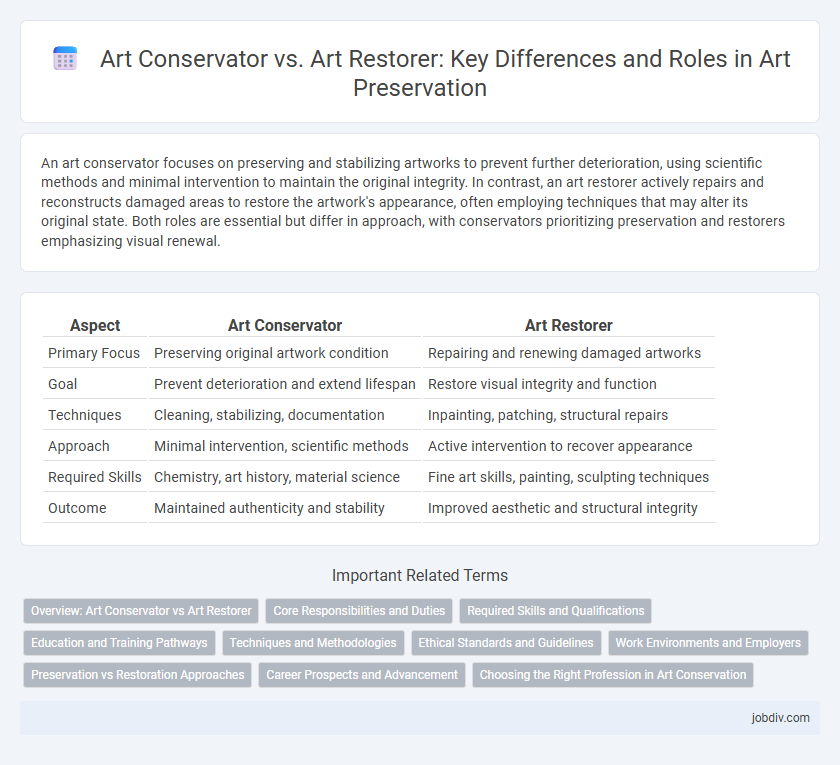An art conservator focuses on preserving and stabilizing artworks to prevent further deterioration, using scientific methods and minimal intervention to maintain the original integrity. In contrast, an art restorer actively repairs and reconstructs damaged areas to restore the artwork's appearance, often employing techniques that may alter its original state. Both roles are essential but differ in approach, with conservators prioritizing preservation and restorers emphasizing visual renewal.
Table of Comparison
| Aspect | Art Conservator | Art Restorer |
|---|---|---|
| Primary Focus | Preserving original artwork condition | Repairing and renewing damaged artworks |
| Goal | Prevent deterioration and extend lifespan | Restore visual integrity and function |
| Techniques | Cleaning, stabilizing, documentation | Inpainting, patching, structural repairs |
| Approach | Minimal intervention, scientific methods | Active intervention to recover appearance |
| Required Skills | Chemistry, art history, material science | Fine art skills, painting, sculpting techniques |
| Outcome | Maintained authenticity and stability | Improved aesthetic and structural integrity |
Overview: Art Conservator vs Art Restorer
Art conservators specialize in preserving and stabilizing artworks to prevent further deterioration, employing scientific methods to analyze materials and environmental conditions. Art restorers focus on repairing and reconstructing damaged pieces, often using historical research to faithfully restore the original appearance. Both roles require deep knowledge of art history, chemistry, and materials science to ensure the longevity and authenticity of cultural heritage.
Core Responsibilities and Duties
Art conservators specialize in preventive care and long-term preservation of artworks, applying scientific methods to stabilize materials and prevent deterioration. Art restorers focus primarily on repairing and reconstructing damaged or deteriorated pieces to restore their original appearance. Both roles involve detailed analysis and hands-on treatment, but conservators emphasize preservation while restorers prioritize aesthetic renewal.
Required Skills and Qualifications
Art conservators require advanced knowledge in chemistry, art history, and materials science to analyze and preserve artworks without altering their authenticity, often holding a master's degree in conservation. Art restorers prioritize fine craftsmanship, artistic techniques, and historical accuracy to repair and reconstruct damaged pieces, typically possessing specialized training in painting, sculpture, or relevant artistic practices. Both roles demand meticulous attention to detail, proficiency in documentation, and a deep understanding of cultural heritage preservation standards.
Education and Training Pathways
Art conservators typically pursue advanced degrees in conservation science or related fields, combining chemistry, history, and hands-on training to understand material composition and decay processes. Art restorers often acquire skills through specialized workshops, apprenticeships, or fine arts programs that focus on techniques to repair and enhance artworks aesthetically. Both roles require a strong foundation in art history and materials science, but conservators emphasize scientific analysis, while restorers prioritize practical restoration techniques.
Techniques and Methodologies
Art conservators employ scientific methods such as X-ray fluorescence and infrared spectroscopy to analyze materials and stabilize artworks without altering their original integrity. Art restorers focus on aesthetic techniques like inpainting, varnishing, and structural repairs to visually recover damaged or aged pieces. Both utilize specialized tools and materials, but conservators prioritize long-term preservation while restorers emphasize visual renewal.
Ethical Standards and Guidelines
Art conservators adhere to strict ethical standards emphasizing minimal intervention, reversibility, and documentation to preserve the artwork's originality and historical integrity. Art restorers often focus on the aesthetic recovery of pieces, which can sometimes blur ethical boundaries if changes compromise authenticity. Professional guidelines from organizations like the American Institute for Conservation underscore the importance of transparency, respect for the artist's intent, and preventing irreversible alterations in conservation practices.
Work Environments and Employers
Art conservators primarily work in museums, galleries, and academic institutions where they focus on preventive care and detailed analysis of artworks. Art restorers are often employed by private collectors, restoration workshops, and antique dealers, targeting aesthetic repair and surface refinishing of damaged art pieces. Both professions may collaborate with cultural heritage organizations and conservation labs to ensure the preservation and longevity of valuable artworks.
Preservation vs Restoration Approaches
Art conservators prioritize preservation techniques to stabilize and protect artworks from further deterioration, employing scientific analysis and preventive measures. Art restorers focus on restoring the visual integrity of damaged pieces by repairing and reconstructing parts, often using materials and methods that align with the original artist's intent. Both roles are essential but differ fundamentally in approach: conservation emphasizes maintaining original material, while restoration aims to revive aesthetic appearance.
Career Prospects and Advancement
Art conservators specialize in preserving and stabilizing artworks, employing scientific methods to prolong the life of cultural heritage, often leading to careers in museums, research institutions, and conservation laboratories. Art restorers focus on repairing and reconstructing damaged pieces, requiring strong artistic skills and often working in private studios or galleries, with advancement based on portfolio strength and client relationships. Both fields offer opportunities for professional development through specialized certifications and memberships in organizations such as the American Institute for Conservation (AIC).
Choosing the Right Profession in Art Conservation
Art conservators specialize in preserving and stabilizing artworks to prevent further deterioration, employing scientific methods to maintain original materials and historical integrity. Art restorers focus on repairing and enhancing damaged pieces, often reconstructing missing elements to restore aesthetic value. Selecting the right profession depends on interest in analytical preservation techniques versus hands-on restorative craftsmanship within art conservation.
Art Conservator vs Art Restorer Infographic

 jobdiv.com
jobdiv.com